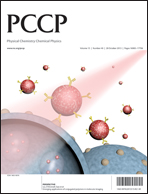First principles prediction of an insensitive high energy density material†
Abstract
A new high performance yet insensitive explosive is proposed, based on an extensive computational study of tris(tetrazolyl)amine in the solid state and in the gas phase. The calculations for the solid state employ the PBE density functional with empirical dispersion correction while the gas phase calculations use the higher level of B3LYP and MP2. Two stable crystalline structures of tris(tertrazolyl)amine were located belonging to P1 and P21 space groups. The crystal structures obtained reveal that solid tris(tertrazolyl)amine is organized in layers with a very small interlayer spacing, due to π stacking, as well as significant inter and intra-molecular hydrogen bonding. Application of these results to the calculation of the detonation velocity and pressure indicate high performance for both phases, especially the P21 phase. At the same time the small value found for the interlayer spacing and the significant hydrogen bonding suggest relatively high stability. These results point to a promising new explosive material with a balance between high performance and insensitivity.


 Please wait while we load your content...
Please wait while we load your content...